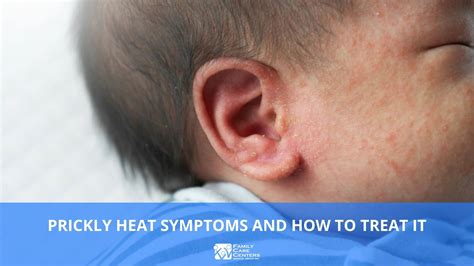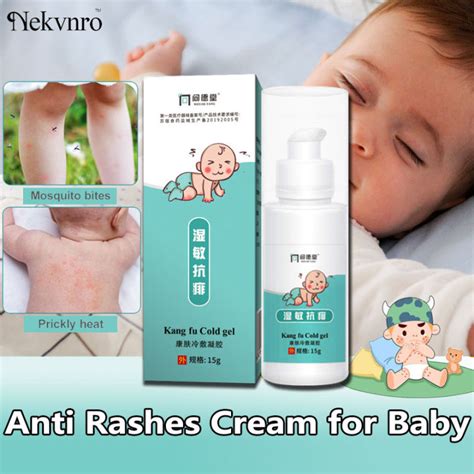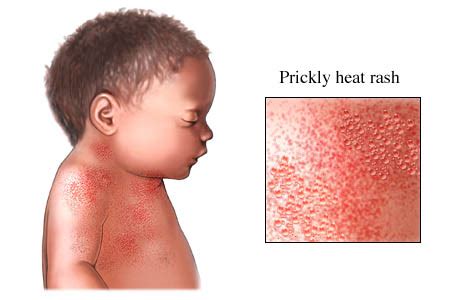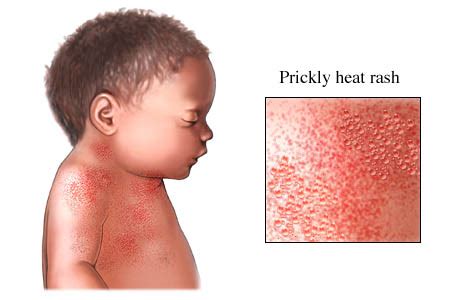Intro
Discover effective infant prickly heat treatment options, including natural remedies and home care tips, to soothe and calm heat rash symptoms in babies and toddlers, promoting comfortable skin and relieving irritation.
Infant prickly heat, also known as heat rash or miliaria, is a common condition that affects many babies during the warm summer months. It is characterized by small, red bumps or blisters on the skin, often accompanied by itching and discomfort. As a parent, it can be distressing to see your little one suffering from this condition, but fortunately, there are several effective treatment options available.
Prickly heat in infants is usually caused by blocked sweat ducts, which can be triggered by overheating, humidity, and friction from clothing. When the sweat ducts become blocked, the sweat cannot escape, leading to the formation of small bumps or blisters on the skin. This condition can occur anywhere on the body, but it is most common in areas where the skin folds, such as the neck, armpits, and groin.
It is essential to recognize the signs and symptoms of prickly heat in infants, as prompt treatment can help alleviate discomfort and prevent complications. Some common signs and symptoms of prickly heat in babies include red, inflamed skin, small bumps or blisters, itching, and irritability. If you suspect that your baby has prickly heat, it is crucial to consult with your pediatrician for proper diagnosis and treatment.
Causes and Risk Factors

Some babies are more prone to developing prickly heat than others, particularly those who are overdressed or exposed to high temperatures. Premature babies, babies with eczema or other skin conditions, and babies who are taking certain medications may also be at increased risk of developing prickly heat.
Symptoms and Diagnosis
The symptoms of prickly heat in infants can vary in severity, but they often include red, inflamed skin, small bumps or blisters, and itching. In some cases, the affected area may become crusty or scaly, and the baby may become irritable or fussy. To diagnose prickly heat, your pediatrician will typically perform a physical examination and take a medical history.During the physical examination, your pediatrician will look for signs of prickly heat, such as redness, inflammation, and small bumps or blisters. They may also ask questions about your baby's symptoms, such as when they started, how long they have lasted, and whether they have been accompanied by any other symptoms.
Treatment Options

Some common home remedies for prickly heat in infants include:
- Keeping the affected area cool with a cool compress or fan
- Reducing friction from clothing by dressing your baby in loose, lightweight clothing
- Applying topical creams or ointments, such as calamine lotion or hydrocortisone cream
- Giving your baby a cool bath to help reduce the temperature and relieve itching
In some cases, your pediatrician may recommend over-the-counter medications, such as antihistamines or topical steroids, to help relieve symptoms. However, it is essential to follow their instructions carefully and only use medications as directed.
Prevention
Preventing prickly heat in infants is often easier than treating it, and there are several steps you can take to reduce your baby's risk of developing this condition. Some common prevention strategies include: * Dressing your baby in loose, lightweight clothing * Keeping your baby cool, particularly in warm weather * Reducing humidity in your home, particularly in areas where your baby spends most of their time * Avoiding tight or constricting clothing, particularly in areas where the skin folds * Keeping your baby's skin clean and dry, particularly in areas prone to sweatingBy following these prevention strategies, you can help reduce your baby's risk of developing prickly heat and minimize the discomfort and distress associated with this condition.
Complications and When to Seek Medical Attention

If you notice any of these symptoms, you should contact your pediatrician immediately. They can assess your baby's condition and provide guidance on the best course of treatment.
In addition to infection, prickly heat can sometimes lead to scarring, particularly if the affected area becomes crusty or scaly. To minimize the risk of scarring, it is essential to keep the affected area clean and dry and to avoid picking or scratching the bumps or blisters.
Home Care and Follow-Up
If your baby has been diagnosed with prickly heat, it is essential to follow your pediatrician's instructions for home care and follow-up. This may include applying topical creams or ointments, keeping the affected area cool, and reducing friction from clothing.You should also follow up with your pediatrician as directed to ensure that the condition is resolving and to address any concerns or questions you may have. Some common follow-up questions to ask your pediatrician include:
- What are the best ways to keep my baby's skin cool and dry?
- How can I reduce friction from clothing and prevent further irritation?
- What are the signs of infection, and when should I seek medical attention?
- How long will it take for the condition to resolve, and what are the chances of recurrence?
By following your pediatrician's instructions and taking steps to prevent prickly heat, you can help your baby feel more comfortable and reduce the risk of complications.
Conclusion and Next Steps

By recognizing the signs and symptoms of prickly heat, taking steps to prevent it, and following your pediatrician's instructions for home care and follow-up, you can help your baby feel more comfortable and reduce the risk of complications. If you have any concerns or questions about prickly heat or your baby's skin health, do not hesitate to reach out to your pediatrician for guidance and support.
We invite you to share your thoughts and experiences with prickly heat in the comments below. Have you ever dealt with this condition in your baby, and if so, what steps did you take to treat it? What are some common misconceptions about prickly heat, and how can we work together to raise awareness and promote better skin health for infants?
What is prickly heat, and how does it affect infants?
+Prickly heat, also known as heat rash or miliaria, is a common condition that affects many babies during the warm summer months. It is characterized by small, red bumps or blisters on the skin, often accompanied by itching and discomfort.
What are the causes and risk factors of prickly heat in infants?
+Prickly heat in infants can be caused by several factors, including overheating, humidity, and friction from clothing. Some babies are more prone to developing prickly heat than others, particularly those who are overdressed or exposed to high temperatures.
How can I treat and prevent prickly heat in my baby?
+There are several treatment options available for prickly heat in infants, including home remedies, over-the-counter medications, and prescription medications. To prevent prickly heat, you can take steps such as dressing your baby in loose, lightweight clothing, keeping them cool, and reducing humidity in your home.
